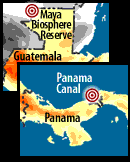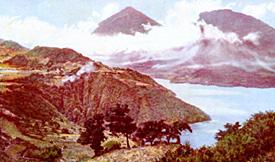|








|
 |
Pick a Region:.
. Central America

Terrain
A common geographic characteristic of Central America is the chain
of rugged mountains extending through the center of the region. These
towering mountains rise as high as 14,000 feet. The highest mountain
is in Guatemala. On each side of these highlands exists lowlands along
the Atlantic and Pacific coasts. The lowlands are generally hot, humid,
and often plagued by disease, while the highlands are cooler and drier.
Coastal lowlands exist on each side of the mountain ranges. With the
exception of El Salvador (which does not border the Atlantic), each
of the other five Central American republics
borders the Atlantic and Pacific Oceans.
Image:Rendition
of volcano and Lake Atitlan in Guatemala, Central America. Image ©
1999 - www.arttoday.com

Natural Disasters
One of the most dramatic geographical characteristics of Central America is the natural
disasters that periodically strike the region. Although the volcanic mountains that run
from Guatemala through Panama are very scenic, they can also be devastating when they
erupt. Historically, these volcanic eruptions have wreaked havoc on each of the Central
American countries. Hurricanes and the resulting floods affect the lowlands. In December
1998, Hurricane Mitch devastated Central America, especially Honduras and Nicaragua,
leaving thousands dead and even more homeless. Earthquakes, like the one in Managua,
Nicaragua in 1972, are just one more natural disaster that affect the region periodically.
Natural Resources
The region contains some valuable natural resources, including nickel, iron ore, fish,
timber and oil. Unfortunately, the digging and mining of some of these resources has
created environmental problems. For example, mining in Honduras has led to water
pollution. The logging of timber has led each of the six countries to unsustainable rates
of deforestation.
The Panama Canal
Panama has a unique geographic factor. Given its narrowness, Panama provided the most
convenient place to build a path (the Panama Canal) between the Atlantic and Pacific
Oceans. The Canal allows ships sailing from the Atlantic to the Pacific Ocean (or visa
versa) to go through the Canal as a way to avoid going around South America. Sailing
though the canal can save a great amount of time and money. |
 |



    
|

